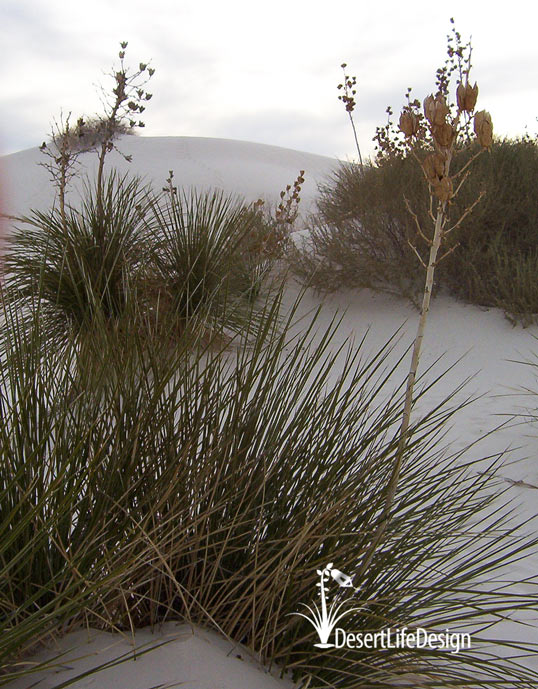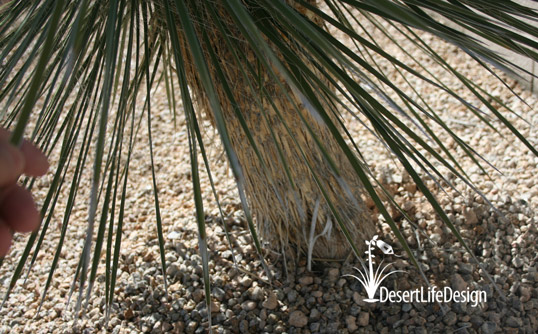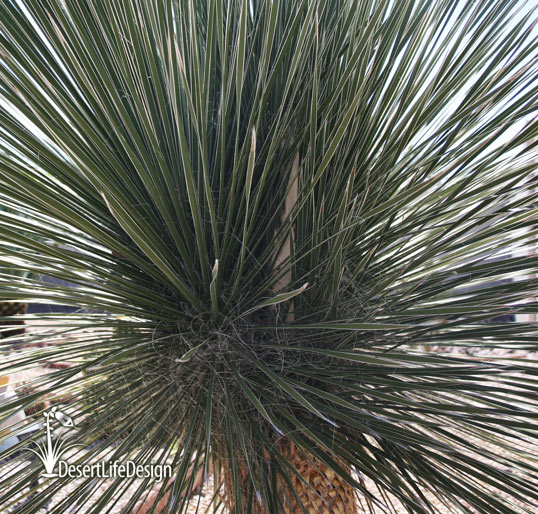How to grow the soaptree yucca
Grow the soaptree yucca
Here in the southwestern desert at Desert Life Design, we use graphic design, photography, and creative writing to create a compelling call-to-action.

How to grow the soaptree yucca
by Doug M. at Desert Life Design
The soaptree yucca (Yucca elata) is another icon of the southwestern United States. Just like the saguaro cactus, the soaptree yucca evokes images of survival in even the most harsh environments.
I have three soaptree yuccas in my landscape. My neighbors have told me how much they love when the sun shimmers off its long, thin leaves in the morning sun. Thankfully for us plant-lovers, this lovely yucca is extremely easy to plant and to grow.
How to grow the soaptree yucca
Required tools:
- Gardening or pruning gloves
- Soil amendments like sand, vermiculite or perlite (to make soil drain better)
- Shovel
- 5 gallon bucket
Only use the soil amendments if you don't have soil that drains well. For instance, in the southwestern United States we have caliche, clay-based soil in many locations. If your soil has lots of clay, you might consider those soil amendments
With the soapbox yucca, you do not need to add peat moss or compost as is suggested on some websites. Peat moss could cause the roots to rot. Above all, make sure your soil is well-draining!
1. Select a good location
Soil that drains well.. Select a location with well-draining soil. In my landscape, I created small mounds so excess moisture drains away from the trunk.
Sunny and hot. Since this yucca thrives in hot, sunny locales, almost any hot and sunny location will be ideal for this heat-tolerant yucca. However, some dappled shade will also work well. One of my soaptree yuccas is growing where it only receives morning sun, and it is thriving!
Poor soil conditions are like 'home-sweet-home' for this yucca. In the photo at the top of the page, you'll see soaptree yuccas growing in a dry, sandy arroyo near the Organ Mountains. And in the majestic White Sands National Park, I photographed other yuccas growing in a sandy surrounding, and possibly a clay-based soil underneath (see photo below ).

Add amendments, just in case. However, if you have a clay-based, caliche soil, you might add sand and perlite. Those amendments will allow excess water to drain away, while still retaining some moisture and nutrients that the plant can use later.
I didn't add any amendments to my caliche soil in my landscape for these yuccas, and they are performing splendidly.
2. Dig a large hole
Once you have a great location selected, then, dig a large hole. It should be at least two or three times wider than the container. The extra space will allow the roots to easily extend into the surrounding area, especially if you add soil amendments.
3. Prepare your yucca for planting
If your new plant is root-bound, you can tease out some of the roots with your fingers. That way, the roots won't continue growing in a circle. Root-bound plants, no matter what variety they are, will suffer for the rest of their lives and their roots continue to wrap around the base of the plant.
When I slid my new soaptree yucca out of its plastic container, it was not root-bound and most of the loose soil fell away from the roots. (See photo below). Maybe that will happen for you, too.

3. Place the yucca into its new home
Now you are ready to place your new soaptree yucca into the hole. Before you backfill, mix in your soil amendments and use about a 50/50 mixture of amendments to old soil.
Put amended soil back in the soil. Place the amended soil back in the hole and fill in around the plant. If you have some help to hold the yucca straight, that would probably help.
Don't plant this yucca too deep, or the trunk might rot.
4. Water deeply
Tamp the soil down around the plant, but don't tamp too hard. Then, water deeply so the water penetrates deep into the soil.
You might also want to use the soil to create a circular little dam around the circumference of your plant. The soil-dam will help retain water as it seeps into the ground. I'd recommend going about 12-16 inches out from the trunk and going around the circumference. Make the wall a few inches high.
Use your foot or shovel to fill in the hole and compact the soil around the base.
Only five years later...
...my little soaptree yucca grew into a large, beautiful little tree. In another five years, this tree might become a focal point in my landscape!


Where to find a soaptree yucca
If you live in the southwestern parts of the United States, you might look for a soaptree yucca in a local garden center that carries native plants. In the Phoenix, Arizona area, there are quite a few native plant nurseries.
And if you prefer getting yours delivered directly to your front door, do an internet search. There are at least a few greenhouses that ship out cacti, succulents and yuccas.
☙
Writing and photographs from Doug M. at Desert Life Design! If you'd like to read more about xeriscaping your landscape, please click here.

Desert Life Design™ is based in the Phoenix, Arizona metro area. Here, we strive for perfection in graphic design and concise written communications.
